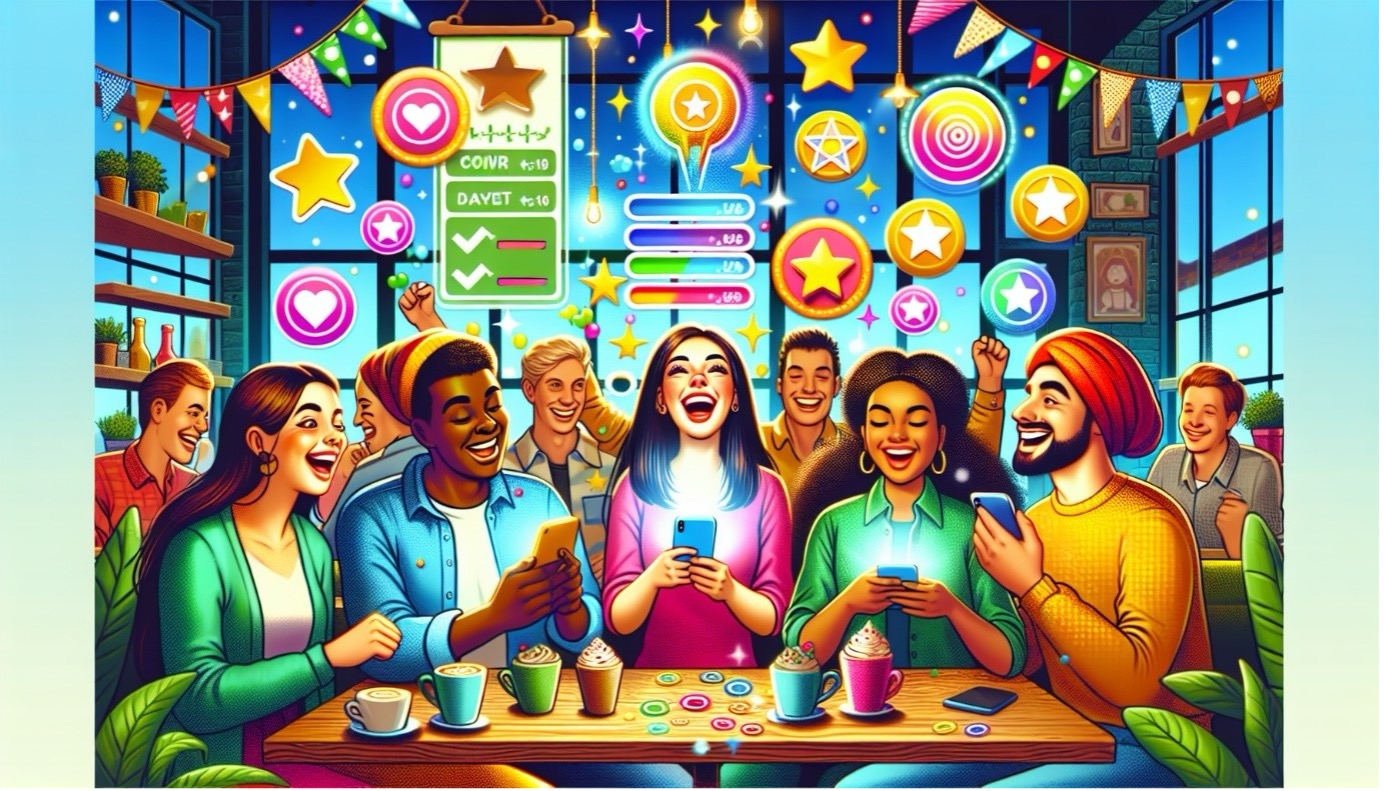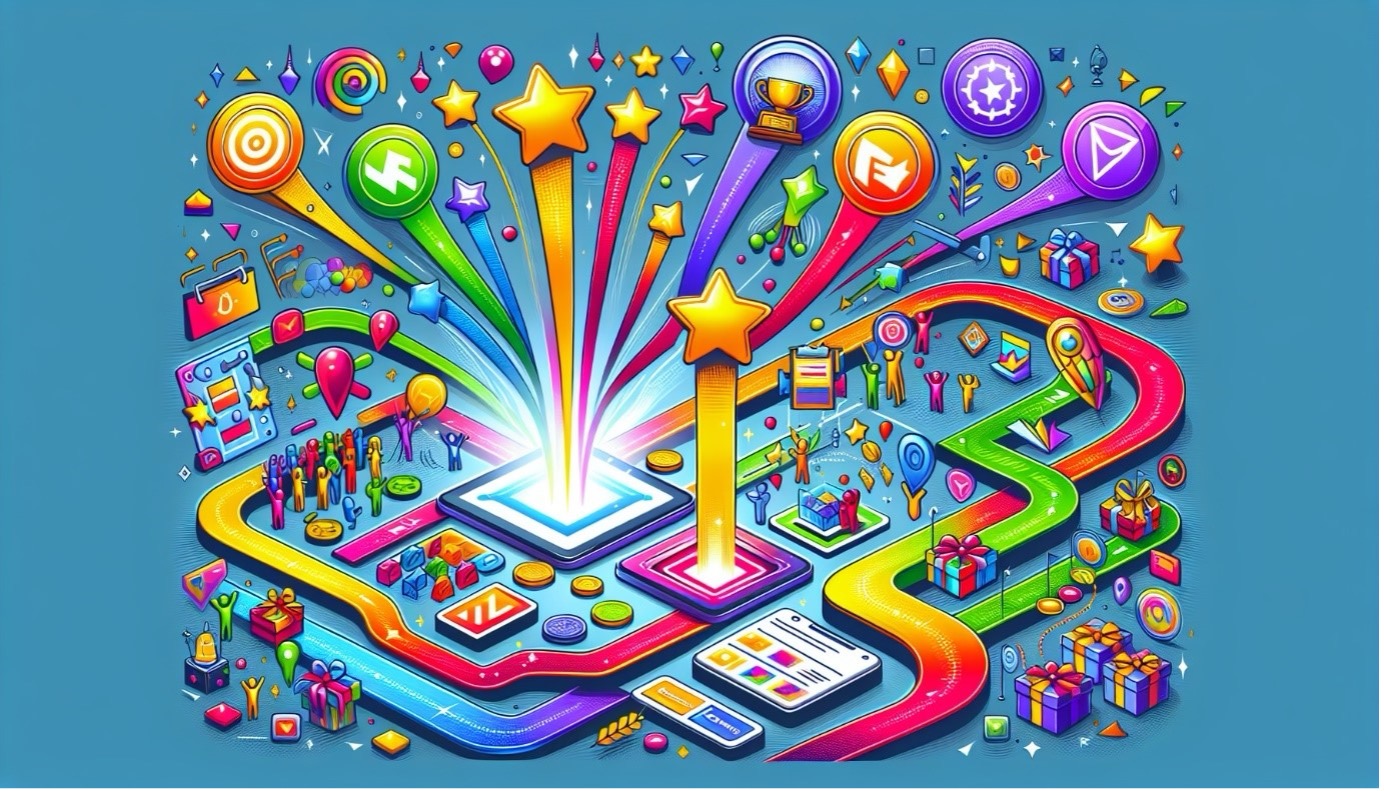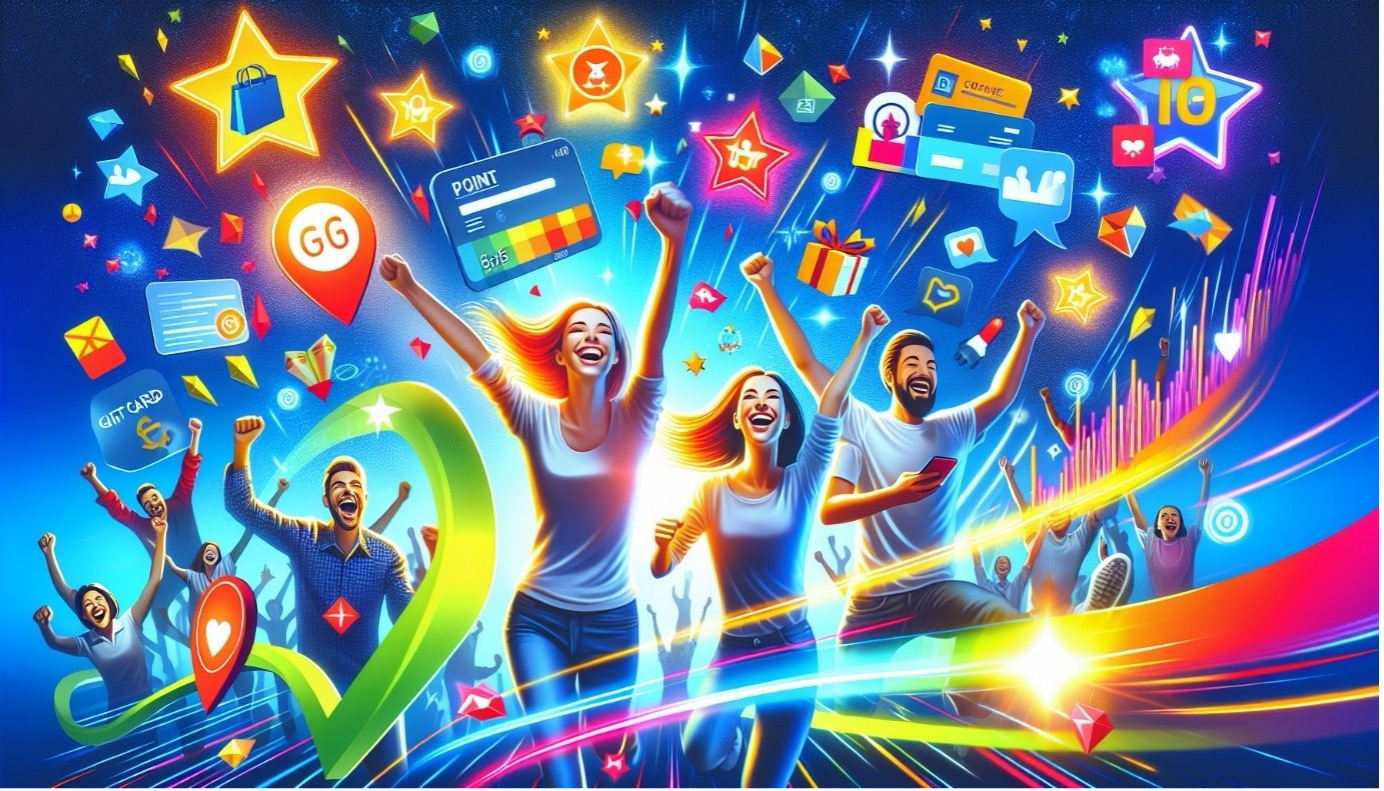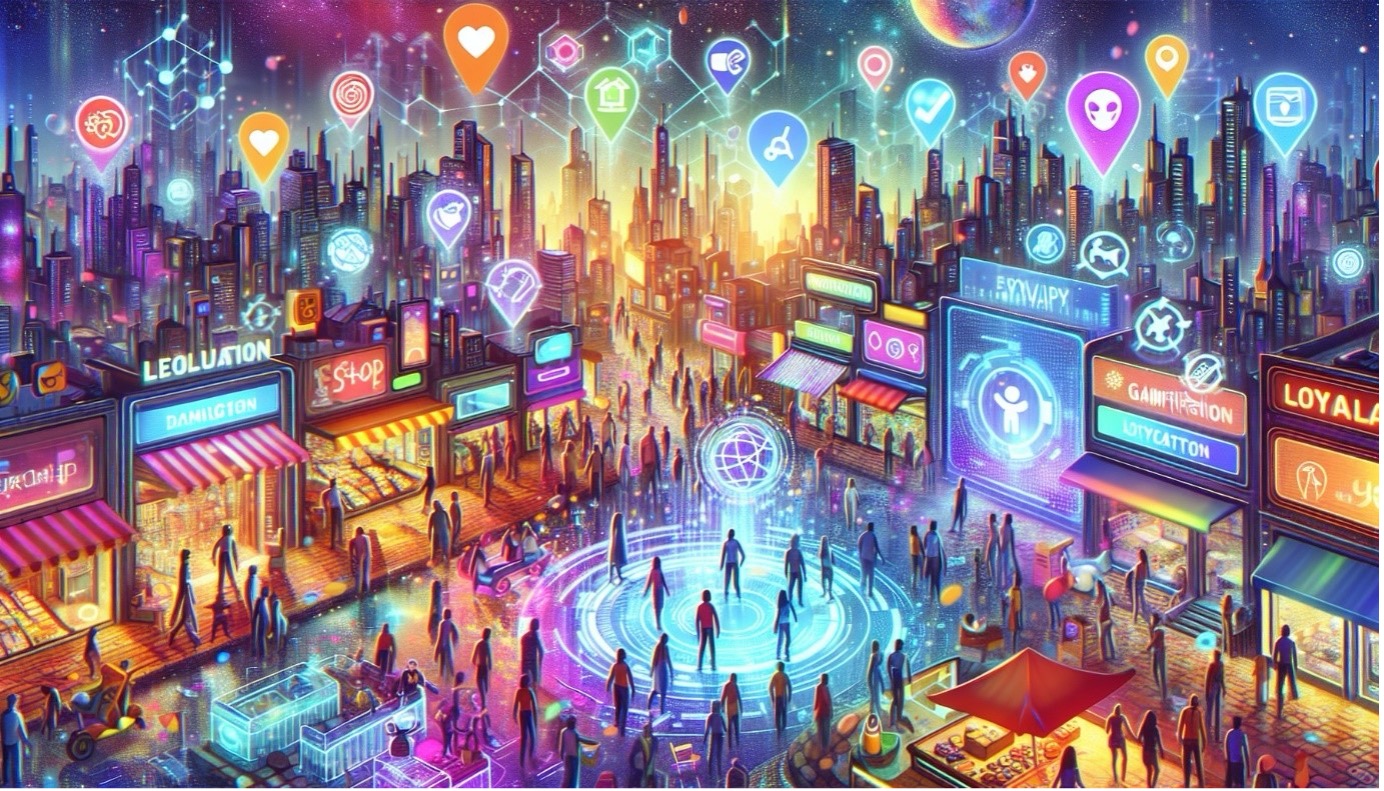Gamification in loyalty programmes adds game elements to regular interactions, making them more engaging and fun. This can drive customer engagement and loyalty. In this article, discover top strategies to incorporate gamification into your loyalty programme and keep your customers coming back. Ready to turn your loyalty program into an engaging journey? Let’s dive in!
Key Takeaways
-
Gamification boosts customer engagement and loyalty by integrating game-like mechanics, such as points, badges, and challenges, into loyalty programmes.
-
Embracing future trends like AI, AR, and blockchain can further personalise and enhance gamified loyalty programmes, driving deeper connections and customer retention.
Understanding Gamification in Loyalty Programmes

Gamification is an advanced marketing strategy that uses game design elements within regular loyalty programmes to engage customers and enhance their experience. Incorporating game-like features such as points, badges, and leaderboards motivates users to interact more frequently with the brand.
The ultimate goal of gamification in loyalty programmes is to drive engagement, increase customer satisfaction, and build emotional connections. As technology and customer preferences evolve, gamification has become an integral part of modern business strategies, transforming how companies reward and retain their customers.
What is gamification?
Gamification involves the use of game mechanics and experience design to digitally engage and motivate people to achieve their goals. It strategically applies elements like scoring, competitions, and rules of play to encourage desired behaviours in non-game scenarios, particularly in loyalty programmes.
Transforming routine transactions into engaging experiences with features like levels, badges, and quizzes creates a positive and rewarding experience that significantly impacts customer loyalty. While extrinsic rewards initially attract customers, intrinsic motivation, driven by the enjoyment and satisfaction of the gamified experience, sustains their engagement over time.
Additionally, the release of chemicals like dopamine and serotonin during gamified interactions further enhances user engagement.
How gamification enhances loyalty programmes
Gamification elements like points, badges, and leaderboards can significantly enhance engagement in loyalty programmes. Initially, existing customers are motivated by the rewards they can earn from participating in gamified loyalty programmes. However, the real magic happens when these elements blend entertainment with engagement, making the shopping experience more exciting and memorable. For instance, incorporating challenges and missions within loyalty programmes adds an adventure aspect, encouraging customers to explore more products and services. This consistent engagement not only increases customer satisfaction but also builds stronger emotional connections with the brand.
The main goal of implementing gamification in loyalty programmes is to encourage regular interaction with the brand, forming new habits that benefit both the customer and the business. Gamification encourages active participation and motivates desired behaviours, such as frequent purchases and social sharing. Engaging gamification modules lead to increased customer commitment and satisfaction, providing valuable insights into customer preferences and behaviours.
The excitement of competition and the thrill of winning are powerful drivers of engagement in gamified loyalty programmes. Positive reinforcement and appreciation are crucial to sustaining this engagement. Techniques like prize draws, spinning wheels, or scratching cards can attract significant participation, making the loyalty programme more dynamic and appealing.
Key Elements of a Successful Gamified Loyalty Programme

Transforming loyalty programmes into enjoyable experiences requires incorporating key gamification elements. Successful gamified loyalty programmes typically include points and rewards systems, levels and tier progression, and challenges and missions. These elements create a structured and engaging environment where customers can earn points, progress through levels, and complete challenges to achieve rewards. Regularly introducing new gamified elements keeps the experience fresh and exciting for customers, ensuring long-term engagement. These elements not only engage customers but also strengthen the business relationship by rewarding continued engagement and support.
Moreover, designing inclusive loyalty programmes allows diverse customer engagement beyond just spending, making the programme accessible and appealing to a broader audience.
Points and rewards systems
Points and rewards systems are fundamental to gamified loyalty programmes. Members earn points for purchases or specific activities, which they can redeem for a rewards programme. For example, Sephora’s Beauty Insider Programme encourages repeated purchases by issuing points for every purchase.
This system dates back to the 1980s when airlines introduced free miles as a way for customers to earn points. Customers can also earn points by leaving reviews or participating in non-purchase activities.
The simplicity and effectiveness of punchcards, which encourage repeat purchases, demonstrate the enduring appeal of points-based systems.
Levels and tier progression
Levels and tier progression add a layer of excitement and motivation to loyalty programmes. Customers start as beginners and can advance to elite status, unlocking increased benefits and rewards along the way. Earning points through brand engagement allows customers to move through different tiers, each offering new perks and incentives.
Gamification elements like leaderboards and progress indicators further incentivise engagement by allowing customers to track their progress and compare themselves to others. This tiered structure not only motivates customers but also fosters a sense of achievement and competition.
Challenges and missions
Challenges and missions are essential components of gamified loyalty programmes, engaging customers by encouraging them to explore products and services more deeply. For instance, a treasure hunt game where customers search for marked products to earn prizes can enhance the interactive experience. Other examples include virtual scavenger hunts or quests that offer more rewards than simple purchases.
Leaderboard competitions and instant-win mechanics like spinning wheels provide immediate gratification and the thrill of winning, further motivating participation. Badges serve as visual representations of achievements, encouraging customers to share their progress and engage with the programme.
Benefits of Gamification in Loyalty Programmes

Incorporating game-like elements into loyalty programmes offers numerous benefits, significantly enhancing customer engagement and satisfaction. Gamification can lead to increased consumer involvement, deeper emotional connections to the brand, and improved customer retention.
By understanding different customer preferences and motivations, gamified loyalty programmes can personalise rewards and experiences, driving higher engagement and loyalty. Additionally, businesses that adopt gamification strategies often see notable increases in direct and indirect sales.
Increased customer engagement
Gamification turns loyalty programmes into engaging experiences that captivate customers’ attention. Gamification enhances engagement by encouraging customers to interact more frequently with the brand. Transforming everyday interactions into opportunities for deeper brand connections is a powerful way to boost customer engagement. Seeing their progress and earning rewards provides a psychological benefit, creating a feeling of achievement and satisfaction. Immediate feedback and virtual rewards effectively motivate customer participation, keeping them engaged over time.
Setting up multiple milestones in gamified loyalty programmes keeps customers engaged with short-term goals and rewards. Points systems are effective tools for driving customer engagement. They are also simple and sustainable. Customers often receive special discounts or free products as rewards upon reaching predefined milestones, further incentivising their participation.
The redemption rate, which indicates how frequently loyalty points are exchanged for rewards, reflects customer satisfaction with the programme. Higher customer engagement results in greater interaction with the brand. This, in turn, improves customer retention.
Enhanced brand loyalty
Gamified loyalty programmes can create strong emotional connections, making customers feel more valued and appreciated. Achieving milestones, earning rewards, and unlocking achievements help customers associate positive emotions with the brand, fostering deeper emotional loyalty. This emotional connection is crucial for long-term brand loyalty, as customers who feel positively about a brand are more likely to remain loyal and make repeat purchases.
Gamification also fosters community building among customers through shared experiences and interactions. Effective gamification strategies encourage customers to share their experiences, leading to increased brand awareness and a sense of belonging. This sense of community and shared achievement strengthens the bond between the brand and its customers, enhancing overall brand loyalty.
Improved customer retention
Gamification can significantly enhance customer retention by motivating repeat purchases and reducing churn rates among loyal customers. By offering engaging and rewarding experiences, gamified loyalty programmes create a sense of commitment
and satisfaction among customers. This consistent engagement encourages customers to stay loyal to the brand, making them less likely to switch to competitors.
Additionally, personalised rewards and experiences based on customer preferences further enhance retention, as customers feel their needs and desires are being met.
Examples of Effective Gamified Loyalty Programmes
Real-world examples of successful gamified loyalty programmes provide valuable insights into how gamification can be effectively implemented. These examples demonstrate the diverse ways in which businesses can use gamification to enhance customer engagement, loyalty, and retention. These examples also highlight the potential for B2B loyalty programmes to enhance business relationships and drive customer retention in corporate settings.
From treasure hunts to interactive loyalty apps, these programmes showcase the potential of gamification to transform loyalty strategies and deliver significant benefits.
Starbucks Rewards
Starbucks Rewards is a prime example of a successful gamified loyalty programme. It employs a tiered system that offers varying levels of rewards, incentivising customers to earn more stars and elevate their status. By implementing a points system, Starbucks Rewards gamifies the customer experience, motivating consumers to make repeat purchases to achieve higher rewards.
Additionally, Starbucks uses QR codes to redirect customers to mobile landing pages where they can learn about coffee products, enhancing their engagement and knowledge. This combination of points, tiers, and educational content creates a dynamic and engaging loyalty programme that keeps customers coming back.
Domino’s Pizza Hero
Domino’s Pizza Hero app is another excellent example of gamification in action. The app allows customers to customise their pizzas and engage in a fun gaming experience. Features like designing pizzas according to personal preferences and interactive elements encourage customers to engage more deeply with the brand.
This gamified experience resulted in a 30% increase in sales revenue for Domino’s, demonstrating the powerful impact of gamification on business outcomes. By making the ordering process enjoyable and interactive, Domino’s successfully boosted customer engagement and loyalty.
Teleflora's social engagement scheme
Teleflora implemented a points-based social engagement scheme as part of its loyalty programme, which significantly enhanced user interaction. By offering points for various customer actions through its gamified online store, Teleflora saw a 105% increase in traffic from Facebook and a 92% boost in conversion rates. This scheme encouraged customers to engage with the brand on social media, fostering a sense of community and increasing overall engagement.
The success of Teleflora’s social engagement scheme highlights the potential of gamification to drive traffic, conversions, and customer loyalty.
Steps to Implementing Gamification in Your Loyalty Programme
Implementing gamification in your loyalty programme requires a strategic approach. The following steps will guide you through the process, ensuring that your gamified loyalty programme aligns with your brand values and resonates with your target audience.
By identifying your goals and understanding your audience, designing engaging game mechanics, and continuously monitoring and iterating your customer loyalty programme, you can create a loyalty programme that delivers valuable and enjoyable experiences for your customers.
Identify your goals and target audience
Establishing clear goals is crucial for creating a focused strategy for implementing gamification. Your goals should be SMART: specific, measurable, achievable, relevant, and time-bound.
Understanding customer demographics is key to tailoring gamified experiences that resonate with your audience. It’s important to consider the specific requirements of different customer age groups and preferences to ensure your loyalty programme appeals to a broad audience.
Setting clear goals and understanding your target audience helps create a gamified loyalty programme that effectively engages and motivates customers.
Design engaging game mechanics
Designing engaging game mechanics is essential for the success of your gamified loyalty programme. Personalising loyalty programmes based on customer preferences leads to a more engaging and effective experience. Tailoring offers and rewards according to customer data and feedback boosts participation and satisfaction.
Incorporating elements like badges and leaderboards can significantly enhance competition among customers, driving user engagement. Automation and analytics tools are vital for tracking engagement levels and adjusting strategies effectively. Understanding audience preferences and using predictive analytics helps design game mechanics that resonate with customers.
Monitor and iterate
Continuous monitoring of your loyalty programme is essential to tailor it to meet customer needs, enhance engagement, and drive business growth. Regular analysis of customer feedback is vital for optimising gamified loyalty programmes. Furthermore, monitoring tools, such as quality monitoring and analytics tools, can help gauge customer engagement.
Data analysis can reveal issues such as boring challenges, insufficient rewards, or frustrating user interfaces, which need to be addressed. Experimentation with gamification strategies and iterating on features can enhance user experience and engagement.
Measuring the Success of Gamified Loyalty Programmes
Measuring the success of gamified loyalty programmes is crucial for understanding their impact and making necessary adjustments. Employing tools like A/B testing can help determine the effectiveness of various gamification elements. Tracking engagement through QR Codes, branded links, and analytics provides insights into how customers interact with the programme.
Regularly monitoring and analysing gamified campaigns ensures that challenges, rewards, and interfaces remain engaging and effective. Evaluating both short-term and long-term metrics is essential to gauge the overall success of your loyalty programme.
Key performance indicators (KPIs)
Key performance indicators (KPIs) are critical for measuring the success of your loyalty programme. Important KPIs include Net Promoter Score, ROI, Monthly Recurring Revenue, Annual Recurring Revenue, and Customer Lifetime Value. Retention and churn rates are vital metrics to understand customer loyalty and the effectiveness of the loyalty programme.
Data analysis allows for measurement of repeat purchases and engagement levels, providing insights into the programme’s effectiveness. By focusing on these KPIs, you can assess the impact of your gamified loyalty programme and make informed decisions to enhance its performance.
Customer feedback and data collection
Customer feedback and data collection play a crucial role in measuring the success of gamified loyalty programmes. Gathering feedback through surveys can reveal insights into programme effectiveness and areas needing improvement. Personalised surveys and focus groups are effective methods for collecting loyalty programme feedback.
Analysing user engagement metrics, such as click data, helps assess the impact of loyalty programmes on customer behaviour. Regularly collecting feedback from B2B customers is essential for understanding their needs and enhancing the value of the loyalty programme.
Leveraging this data allows businesses to continuously optimise their gamified loyalty programmes to better meet customer expectations.
Overcoming Challenges in Gamified Loyalty Programmes
Implementing gamification in loyalty programmes comes with its own set of challenges. Balancing simplicity and complexity, avoiding customer fatigue, and ensuring fairness and transparency are crucial for maintaining customer engagement and satisfaction.
Addressing these challenges proactively allows businesses to create effective gamified loyalty programmes that deliver long-term benefits.
Balancing complexity and simplicity
Balancing the complexity and simplicity of game mechanics is essential for engaging customers. Keeping the rules and mechanics simple allows for greater engagement, as complicated earning or reward metrics can deter participation. Conversely, overly simple mechanics may seem trivial and fail to capture customer interest.
Therefore, factors such as alignment with business goals, user interests, and achieving the right balance between simplicity and complexity should be considered when designing game mechanics. This balance ensures that the gamified loyalty programme remains engaging and effective.
Avoiding customer fatigue
To prevent customer fatigue in gamified loyalty programmes, it’s essential to blend novelty with genuine value, ensuring that game mechanics are not overwhelming. Regularly refreshing loyalty programmes with new rewards and experiences can keep customer interest alive.
Clearly communicating the value and exclusivity of rewards helps to reward customers by perceiving them as special perks rather than expectations. Introducing variations and limited time offers can also combat fatigue by providing new and exciting opportunities for engagement.
Regular analysis of customer feedback provides insights into maintaining engagement and preventing fatigue. Balancing the frequency and perceived value of rewards is crucial to maintaining enthusiasm in a loyalty programme.
Ensuring fairness and transparency
Fairness and transparency are essential for maintaining customer trust and satisfaction in loyalty programmes. Treating customers as individuals and being clear about what they can expect are vital for establishing trust. Being upfront about the capabilities and limitations of the loyalty programme ensures effective communication with customers.
Implementing these communication strategies can enhance customer satisfaction and loyalty. By maintaining fairness and transparency, businesses can strengthen business relationships with their customers and ensure long-term engagement.
Future Trends in Gamification and Loyalty Programmes

The future of gamification in loyalty programmes is bright, with emerging technologies set to revolutionise how businesses engage customers. The gamification market is expected to reach $40 billion in 2024, driven by innovations in artificial intelligence, augmented reality, and blockchain.
These technologies will enhance personalisation, provide immersive experiences, and ensure secure and transparent transactions, making loyalty programmes more engaging and effective.
Artificial Intelligence and personalisation
Artificial intelligence (AI) enables brands to offer tailored recommendations and personalised experiences based on customer behaviour and preferences. AI can analyse customer data to provide insights and recommendations that enhance customer engagement and satisfaction.
Behavioural personalisation goes beyond traditional data capture to tailor offerings based on how customers interact with products and services. Implementing AI-driven personalisation fosters deeper connections between brands and customers, leading to higher loyalty and better programme outcomes.
Augmented Reality (AR) and Virtual Reality (VR)
Augmented Reality (AR) and Virtual Reality (VR) technologies are expected to enhance customer interactions by providing immersive gamified experiences. AR and VR can offer interactive and engaging environments for loyalty engagement, allowing customers to interact with brands in new and exciting ways.
The overall benefits of using AR and VR in loyalty programmes include increased engagement and enhanced brand loyalty through immersive content.
Blockchain and digital tokens
Blockchain technology offers a secure and decentralised framework that enhances the integrity and reliability of loyalty programmes. By facilitating transparency in transactions, blockchain can significantly reduce fraud and increase trust with customers.
Digital tokens, representing loyalty points on a blockchain, provide a flexible and transferable currency that customers can use across different platforms. The inclusion of digital tokens in loyalty programmes not only improves customer engagement but also fosters a sense of ownership and participation among users.
Summary
Incorporating gamification into loyalty programmes can transform customer engagement, enhance brand loyalty, and improve customer retention. By understanding the key elements of successful gamified loyalty programmes and implementing them strategically, businesses can create engaging and rewarding experiences for their customers. Continuous monitoring and iteration, along with leveraging emerging technologies, will ensure the long-term success of such programmes.
Embrace gamification today to unlock new levels of customer loyalty and drive your business forward.
Frequently Asked Questions
What is gamification in loyalty programmes?
Gamification in loyalty programmes is all about using game-like elements to excite and motivate customers, making their experience more enjoyable and rewarding. By implementing these strategies, you can foster deeper engagement and loyalty among your customers!
How does gamification enhance customer engagement?
Gamification enhances customer engagement by transforming mundane interactions into fun and motivating experiences, encouraging customers to connect with the brand more often. Embrace this strategy to boost loyalty and enthusiasm!
What are some key elements of a successful gamified loyalty programme?
A successful gamified loyalty programme thrives on engaging points and rewards systems, dynamic levels for tier progression, and exciting challenges to keep customers motivated. Embrace these elements to transform your loyalty efforts into a captivating experience!
How can businesses avoid customer fatigue in gamified loyalty programmes?
To prevent customer fatigue in gamified loyalty programmes, regularly refresh rewards and experiences while introducing limited time offers. This keeps customers engaged and excited about participating!
What future trends are expected in gamification and loyalty programmes?
The future of gamification and loyalty programmes looks exciting with the integration of AI, AR, and blockchain, which will boost personalisation and engagement. Embrace these innovations to stay ahead and connect more deeply with your customers!